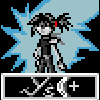I have been thinking about how my players should interact with the enemies. One problem I saw was when the player and the CPU attacked at the same time allowing their attacks to meet each other. Does anyone have any suggestions?
When the Player and the CPU attacks at the same time
Make both of them bounce off each other a few steps back, as if their swords met and blocked each other?
All of the enemies aren't the same size as the character. Also that is the functionality of blocking. would it be redudant to block by blocking and block by attacking too?
All of the enemies aren't the same size as the character. Also that is the functionality of blocking. would it be redudant to block by blocking and block by attacking too?
Blocking is intentional. Two swords striking at the same time is unintentional, and has knock-back.
If you want you can even give an action-test opportunity for quick recovery, no knock-back, and a follow-up strike.
Bonus awesomeness if the enemies can also follow-up, and if you both follow-up the process is repeated (perhaps with a harder action-test).
The good old 'sword lock'? I think Soul Calibur or Bushido Blade had it (or maybe both), you also see it in many a Star Wars movie. In the games, you usually had to mash buttons to try to win the contest, and doing so knocked the opponent back and/or stunned them.
An action test seems alright but I know my inner demon would make grouped enemies act opportunistically. Hmmm this could lead to more strategic play thought. Anything else?
The good old 'sword lock'? I think Soul Calibur or Bushido Blade had it (or maybe both), you also see it in many a Star Wars movie. In the games, you usually had to mash buttons to try to win the contest, and doing so knocked the opponent back and/or stunned them.
That one is nice for popcorn theater (and for that reason, possibly for games, too... since it's what people expect). But it's sooooooooooooooooooooooo much wrong, flawed, screwed up.
Note how although the blade is "sticky" much in the same way as your hands are in e.g. wing chun, it never locks and instead adapts to the direction of pressure, keeping the edge outside your face. The reason is that obviously as soon as the other blade is free to move anywhere, it's free to injure your body, On the other hand, if the blades lock, the physically stronger fighter inevitably wins.
So, instead of mashing buttons, you should need to press the correct button quickly at the correct time.
Anyhow, for equal-size equal-strength opponents, it might be mighty fine to do whatever you like because the audience probably doesn't care if it's reasonable. On the other hand, if there are enemies that are much larger in size than the player, it's kind of silly (Tom&Jerry style) if the player can actually fence with them, no matter how you do it. In such a case, the much larger opponent not only has a strength an order of magnitude higher, but also has much larger range. Which means he can hit the player long before the player could hit him anyway.
Another option is to turn it into a riposte, with the player always being the winner.
the player always being the winner.
...in easy/casual mode. Or in hardcore mode, the enemy is always the winner :)
Games/Projects Currently In Development:
Discord RPG Bot | D++ - The Lightweight C++ Discord API Library | TriviaBot Discord Trivia Bot
the player always being the winner.
...in easy/casual mode. Or in hardcore mode, the enemy is always the winner
Or have it based upon certain weapons / characters / etc. Can't riposte Boss B, but you can Boss A. Or you can if you're using a rapier, but not if you're using a claymore, or what have you.
Personally, I still lean towards the lock, realism be damned, because it's the most 'fair' to both parties, easily understandable what happened, and can add an extra frenzied moment of gameplay as the player has to either mash buttons or do some sort of QTE, etc.








